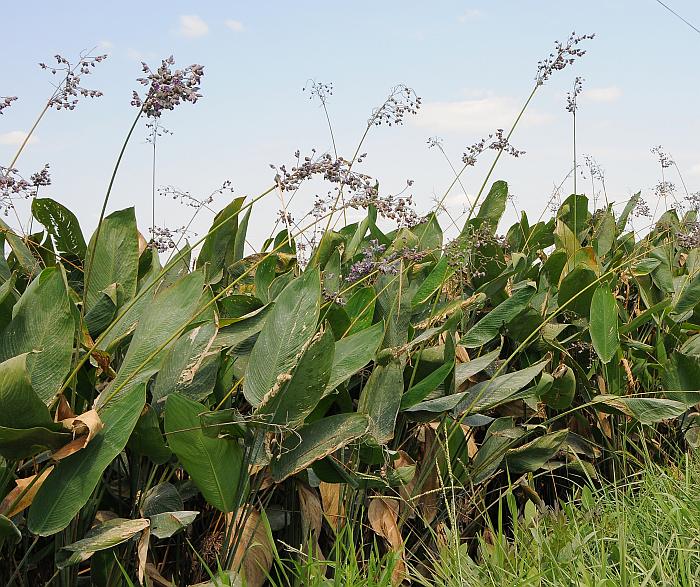Thalia dealbata Fraser ex Roscoe
Thalia

Native
CC = 8
CW = -5
MOC = 5
SRank = S2
© SRTurner
Thalia dealbata Fraser ex RoscoeThalia | |
 |
Native CC = 8 CW = -5 MOC = 5 SRank = S2 |
© SRTurner |
|
Family - Marantaceae Habit - Perennial forb with thick rhizomes. Leaves - To 3 m long, with petioles exceeding blades. Petiole base with sheathing stipules, bases sheathing one another and appearing as a false stem. Blades to 0.5 m, ovate to oblong, usually glaucous.
Inflorescences - Panicles, coated with white powder. Peduncles to 2 m long, arching. Flowers paired along inflorescence branches.
Flowers - Flowers perfect, surrounded by 2 papery to leathery bracts. Sepals 3, 1-1.5 mm long, thin, papery. Petals 3, 7-9 mm long, basally fused, purplish blue, the upper petal broader than the 2 lateral ones. Staminodes 3, 7-12 mm long, purple, enlarged and petalloid. Outermost lower staminode broadly spathulate, appearing as a lower lip. Outermost upper staminode broad, hoodlike. Third staminode narrower, sheathing the style, with 2 linear appendages. Stamen 1, 2-lobed, the upper lobe with a fertile anther, the lower lobe spathulate, petaloid. Ovary inferior, with 1 locule. Style 1, curled at the tip, with a narrowly triangular, curled, apical appendage, the stigmatic area a cavity at the base of the appendage.
Fruits - Fruits globose utricles, 10-14 mm in diameter, purple to brown, the perianth and stamens persisting at the tips.
Flowering - July - August. Habitat - Emergent aquatic in swamps, ponds, and wet ditches. Origin - Native to the southern U.S. Lookalikes - None. Other info. - This unmistakable species is found in Missouri only in the Missouri Lowlands Division, with the remainder of its natural range extending mostly southward. The flowers are bizarre, with showy staminodes and a reduced perianth. This is one of the largest herbaceous plants in the state and is often cultivated in ponds. Photographs taken at Shaw Nature Reserve, Franklin County, MO, 8-2-2010, 11-13-2016, and 7-20-2017, at Missouri Botanical Garden, St. Louis County, MO, 8-18-2014, and near Neelyville, Butler County, MO, 8-27-2015 (SRTurner). |